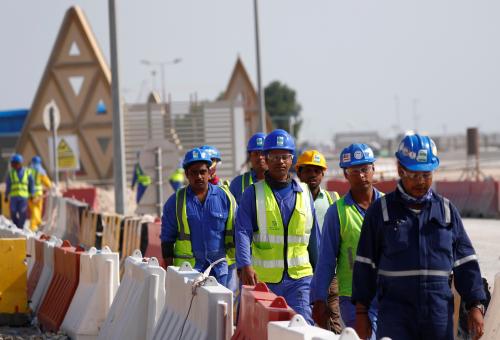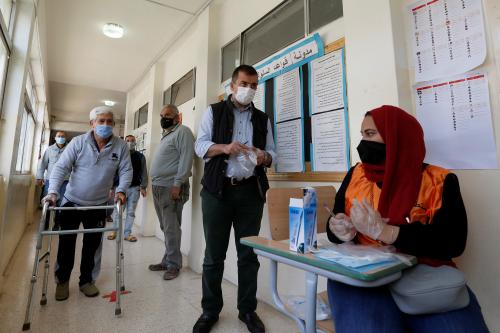Content from the Brookings Doha Center is now archived. In September 2021, after 14 years of impactful partnership, Brookings and the Brookings Doha Center announced that they were ending their affiliation. The Brookings Doha Center is now the Middle East Council on Global Affairs, a separate public policy institution based in Qatar.
This piece originally appeared in The International Economy.
After the beginning of the oil price crash of 2014-2015, member countries of the GCC (Bahrain, Kuwait, Oman, Qatar, Saudi Arabia, and the UAE) faced the longest period ever recorded of monthly consecutive losses in foreign exchange reserves. In 2015 and 2016, according to data from the International Monetary Fund (IMF), the GCC accumulated fiscal deficits of US$ 268 billion, current account deficits of US$ 64 billion and foreign exchange reserve losses of US$ 201 billion.
During this period, a number of other oil-exporting countries had to either float their currencies and depreciate (Russia, Kazakhstan, Azerbaijan, Nigeria and South Sudan) or endure the consequences of “back door” floating because of the free fall of their currencies in parallel exchange rate markets (Venezuela and Angola). Moreover, 12-month forward premiums in some USD/GCC exchange rates started to reflect market pricing of future devaluations.
In this context, the sustainability of fixed exchange rate regimes in the GCC started to be questioned. Are the GCC countries going to follow suit with some of their OPEC fellows? Why? Is a round of GCC devaluations inevitable? What GCC countries are more vulnerable?
To properly answer these questions, one should start by separating two different issues: the exchange rate regime and the particular price of certain currencies in relation to others. While the first topic is related to the more fundamental question of the macroeconomic policy framework and its responses to real and nominal shocks, the second is related to possible misalignments of exchange rates and the capacity of central banks to support a particular rate.
A closer look at the fundamentals of the GCC economies would still support the idea of fixed exchange rate regimes based on conventional pegs to the U.S. dollar as the optimal macroeconomic policy framework. The reasons are grounded in six main points:
- As small, open, oil-dominant economies in which the per capita petroleum production is very high, GCC countries tend to present large and structural fiscal and current account surpluses, accumulating sizable war chests and holding highly positive net international financial positions. The high level of savings can be used to withstand temporary deficits and avoid large recessionary adjustments.
- Real effective exchange rates are relatively stable because the elastic supply of low-wage expatriate workers from Asia in GCC labor markets restrain pressures for higher wages in the private non-tradable sector (especially construction and services) and prevents cost-push inflation and Dutch disease problems during demand surges, i. e., prevents real exchange rate appreciations during oil booms.
- As underdeveloped financial and capital markets still make the monetary policy relatively ineffective in the GCC (domestic households and firms are very insensitive to changes in real and nominal interest rates), the costs of not having independent monetary policies are low.
- As the stocks of foreign portfolio investments are low and government and government-related entities have a dominant position in total deposits, there are limits for large and persistent gross capital outflows or dollarization in the GCC.
- Fiscal policies are efficient in rebalancing the economy and the political risks of multi-year fiscal retrenchment plans are manageable because reductions in public expenditures are concentrated in sectors dominated by expatriate workers with high mobility and residency permits linked to employment contracts.
- Alternative or more flexible nominal exchange rate anchors such as the IMF Special Drawing Rights or other baskets of major currencies or the Euro or the prices of gold or oil do not provide gains or substantial benefits in terms of overall import or export stability for the GCC. Oil prices are set in U.S. dollars and, curiously, recent changes in the composition of external trade in the GCC were remarkable but dominated by new Asian partners that are also anchored by hard or soft U.S. dollar pegs. This is in line with the very underappreciated fact that the role of the U.S. dollar as an anchor currency for the world economy is much higher today than it was when the GCC countries hard pegged to the American currency in the late 1970s and early to mid-1980s. In addition, any movement towards more flexible exchange rates would pose significant credibility risks to the monetary authorities and heavy demands in terms of institutional reforms in foreign exchange markets and central bank operations.
If the current foreign exchange rate regimes are still the optimum choice, the remaining question is whether currency devaluations would support a rebalancing of the GCC economies. The appropriate answer here seems to be negative. There is a general lack of material benefits from devaluations all across the GCC. Both exports and imports are very inelastic to changes in relative prices, and eventual positive quantity effects in terms of these variables do not offset cost effects in economies where imports dominate the markets for goods and labor. This stands even for GCC economies with a more diversified export base, such as the UAE and Bahrain, where non-oil exports are mostly re-exports or services provided by sectors with a very high rate of expatriate employment. Also, devaluation-based fiscal gains are severely restricted by more expensive imports (a large share of total imports is government-related) and public sector wage adjustments, and real effective exchange rates have not departed from trend in a more significant and persistent way, as compared to other periods in the recent history. According to other international experiences, ineffective devaluations generate pressures for further devaluations, creating severe financial instability.
All of the above makes the case for GCC authorities to manifest willingness and desire to support their currency pegs. But, in the event of persistent imbalances and continued exchange market pressures, are they capable of defending it for long? One of the best ways to assess it is to use different reserve adequacy metrics (import cover, short-term debt to reserves, M2 to reserves, and the IMF weighted ARA metric) to compare current and past situations with possible future scenarios. Except for Bahrain, all GCC countries hold reserves that are above standard precautionary levels and much above historical lows in the 1980s and early and late 1990s. When Stabilization Funds and Sovereign Wealth Funds are included, Kuwait, Qatar and the UAE achieve positions that are a large multiple of the adequate precautionary reserve levels.
Although Bahrain has by far the tighter reality in terms of reserve adequacy, its strategic location and the Sunni-Shia/Saudi-Iranian regional proxy war form a scenario in which its small economy is simply “too important to fail” for the largest GCC economy. Saudi Arabia provides political, institutional and economic support to Bahrain in order to secure the regional geopolitical status quo. Financial markets seem to indeed incorporate these realities. Despite key financial metrics and macro fundamentals, forward markets generally indicate higher probabilities of future currency devaluations in Oman and Saudi Arabia than in Bahrain.
Over the last two years, Saudi Arabia and Oman have been facing bouts of pressures in their currency pegs. However, even under the very dramatic scenario of fiscal and current account deficits at the 2015-2016 levels and no reliance on domestic debt markets, international capital markets or multilateral/regional liquidity support facilities, financial buffers would still be above precautionary levels for a period of 36 to 33 months in Saudi Arabia and 9 to 12 months in Oman.
All in all, despite differences across the region in terms of capabilities to sustain the pegs, the system will likely remain in place for a while in all GCC countries. Demands for exchange rate regime reforms will only come progressively as long-term national objectives are delivered, including broader diversification, labor market nationalization, and financial markets development and integration. Any possible future transition towards more flexible exchange rate arrangements will be a consequence of structural economic changes in the GCC, not one of its causes.
The Brookings Institution is committed to quality, independence, and impact.
We are supported by a diverse array of funders. In line with our values and policies, each Brookings publication represents the sole views of its author(s).




Commentary
Op-edGulf state currency crisis: which way out of the morass?
August 31, 2017